Singapore Airlines: Intensifying Workforce Diversity
Info: 9866 words (39 pages) Dissertation
Published: 26th Aug 2021
EXECUTIVE SUMMARY
Diversity is also referred to as variety and its administration in a multicultural work environment is progressively turning into an important aspect of the enterprise as it pursues other markets. It influences the profitability and productivity of the workforce. The reason for the examination is to incorporate the measurements of decent variety administration in a useful organization.
Notably, the research seeks to give an account of how diversity can be intensified in Singapore airlines. Our research will be based on diversity administration analysis of Singapore airlines and how it impacts the general workforce and its effectivity.
The research additionally features the imaginary part of ‘ideal models of decent variety administration’ and its application to Singapore airlines. The study breaks down a decent variety incorporation model and its particular manner of overseeing assorted variety in the multicultural workforce. The discoveries of the examination will be valuable for our study as it gives a few rules and proposals of different diversity administration.
Keywords: diversity, administration, multicultural, productivity.
Table of contents
CHAPTER TWO: LITERATURE REVIEW
CHALLENGES OF WORKFORCE DIVERSITY
Tools for Managing Workplace Diversity
1. Planning and Implementation
CHAPTER FOUR: FINDINGS AND DISCUSSIONS
Chapter 5: CONCLUSION AND RECOMMENDATIONS
CHAPTER ONE: INTRODUCTION
Due to globalization the world is becoming more and more interlinked and connected. This has increased the need recently for organizations worldwide to get diversified to remain competitive. Diversity or a variety of people refers to a distinction between individuals which can be studied through accepting, understanding, and valuing distinctions among individuals with respect to age, social class, race, ethnicity group, gender, their disabilities or flaws, etc. (Esty et al. 1995). UK’s high level of multiculturalism has always positioned the country as an attractive foreign investment destination. The beginning of the Equality Act of the year 2010 made illegal any selective discrimination at work based on personal characteristics like an individual’s race, cultural origin, their disability, gender, religious inclination, and sexual orientation. However, despite this, many organizations workforce still does not reflect on the country’s diversity, particularly in senior roles. The study is especially important because it also highlights on, someone considered of an ethnic minority origin in Asia.
Aim
To explore the management of diversity in the workplace and ethnic inequalities if any.
Primary objectives:
- Highlighting on the most literature about diversity at the work place, which will be relevant for drawing conclusions and various recommendations.
- Outline the specific methods used by organizations to limit racial discrimination at work.
- Investigate the human resource manager’s perception of diversity administration.
- Identify the methods and tools relevant for managing diversity.
Purpose
The review will look at the traditional methods of diversity management. It will then discuss the benefits and limitations of diversity at the workplace and finally at the current management of diversity at the workplace.
CHAPTER TWO: LITERATURE REVIEW
Diversity is a term broadly used for different things or a mixture of different elements. Diversity administration at work agrees that people are different and unique in a lot of ways. Some may be visible, non-visible, physical abilities, sexual orientation, social class, ethnic background, cultural group etc. (Kossek et al, 2005). The recognition means that the company embraces a variety of people for better opportunities and to gain a competitive edge against other businesses. Workforce diversity has not been of importance across the world until the last two decades. Diversity approach initially emerged from the US and provided an economic incentive to ensure employment equality within organizations. This meant that managers had an economic incentive to drive equality and diversity other than the legal reasons. It has then become an important matter for agencies and governments worldwide. This was due to the human rights movements, innovation, creativity and globalization with the need for organizations to reach out to a bigger market and spread globally. Workforce diversity was created to enable equal opportunities at work. The mantra seeks to ensure that organizations make the most of the available talent, so as to be efficient and attain a better competitive edge in the market. A diverse workforce also enlightens the consumer behaviour and global consumer market.
A variety workforce needs a culture whereby every employee is free to pursue their career objectives without being stopped by their specific age, religious belief, origin etc. (Bryan, 1999). Trying to ensure the workforce is ethnically balanced entails giving the workers their space to use their talents productively and ensuring than no specific workers have an added advantage (Torres and Bruxelles, 1992). Ideas and methods used in diversity management have been adopted by organizations to become more creative, increase productivity and improve organizational effectiveness. A diverse workforce brings a lot of opportunities regarding innovation and new ideas, yet on the other hand, it has many challenges for the managers in the workplace. One of the challenges is when hiring a diverse workforce where the hiring manager has to ensure recruitment of the most suitable candidate and train accordingly.
Benefits of Workforce Diversity
In the current world scenario, the company’s success was directly related to its adaptation to the diversity and realization of its benefits. Understanding the benefits of the workforce diversity is the key to gain competitive advantage. Experts believe that a diverse workforce can result in the contribution of more creative ideas and increased productivity. For example, a company whose priority is excellent customer service would have good customer retention with a variety workforce working in customer relation department. Employing people from different groups allows the company to get numerous solutions towards a common problem. Companies embracing diversity and allowing contribution from their employees have successfully created innovative processes for better working and competitiveness.
Moreover, apart from the innovation brought to the enterprise, a variety workforce is better placed in dealing with a global client base and can better understand the economic, political, legal and social requirements of the foreign customers. Nowadays, the positive reputation of an institution critically relies on the diverse culture of the institution. Job seekers in the market are more interested in companies known to have a diverse workforce because they believe that such businesses do not discriminate. Employees need the assurance before joining that their employers do not mistreat employees depending on their gender, race or ethnicity. Such companies, of course, will gain and retain the best skills due to employee motivation and high morale. Decent variety turns out to be most invaluable when the association needs to extend its point of view. Different technique strategies, or models, to restructure the organization or the method from blocks and a mortar perspective to an online business condition, dispatch another item, make another thought, grow new advertising arrangement, plan another operation, or survey developing patterns from another viewpoint (Adler, 2002).
On the off chance that decent variety is all around overseeing, an association can profit by both synergistic and particular culture points of interest including upgraded imagination, adaptability, and critical thinking abilities (Hayles and Robert, 1982). On the other hand, (Rijamampianina and Carmichael, 2005) contend that assorted variety of a viable group, can be an added advantage for the gathering or association. Just connections that are expected to change will have the capacity to get by in the current business condition. For certain size and deftness to change require abilities and dexterity to learn needs a decent variety. A more diverse work environment will increment authoritative adequacy (Kulik et al, 2008). It lifts the spirit of workers, bring more exceptional access to sections of the commercial centre and upgrade profitability (Thomas & Ely, 1998).
Work place variety more so at these times causes issues in united procedures, on occasion when the association wants representatives to think or evaluate comparable ways. Assorted variety enables interchanges and reconciliation more possible. Individuals from various ethnic backgrounds neglect to comprehend each other. They don’t work in similar courses or at the same place. The potential for expanded vagueness, multifaceted nature and perplexity ends up plainly most elevated when the association or venture requires heading and lucidity joining (Adler, 2002). According to (Cox, 2001) notices that expanding assorted variety shows a double-edged sword; subsequently, the test of overseeing decent variety is to make conditions that limit its capability to be an execution boundary while boosting its ability to improve hierarchical implementation.
CHALLENGES OF WORKFORCE DIVERSITY
There are several problems when it comes to workforce diversity. It is the biggest challenge for the human resource management department and managers as this needs a lot more than simply accepting the differences in individuals. The process requires recognizing the unique impact of culture distinctions, encouraging inclusiveness and preventing discrimination. Bad attitudes and traits are a wall to institutional cultural diversity because they pose a risk to different work relationships, which reflect on employee’s morale and productivity (Esty et al. 1995). It also includes stereotyping, harassment, ethnocentrism, prejudice, and racial discrimination by managers during the different practices of hiring, training, retention, and promotion.
Cultural differences and language can be big barriers to workforce diversity too. In such a Scenario, communication becomes a difficult task if it is not managed effectively by the organization resulting in confusion and low morale. Resistance to change plays a significant role as well. People are not always happy with the modification and will refuse to accept the change incurring due to diversity and would resist keeping the organizational culture unchanged. Diversity management can be a big challenge if there is not a clear strategy to develop an environment of diversity that is incorporated into every aspect of an organization’s function and department. For this purpose, the management needs to create a customised strategy that would enable them to maximise the effectiveness of diversity in the organization.
Racial Discrimination
The Equality Act of 2010 illegalizes discrimination against workers, job seekers, and company trainees because of their race – which includes a variety of elements like colour, nationality, and ethnic or national origin (Beck and Williams, 2016).
Racial discrimination at a workplace can happen in various forms. The four main types of discrimination are included on the Equality Act of the year 2010 and are directed towards direct and indirect discrimination, any form of harassment, and Victimisation. And the major areas of recruitment where there are loopholes for discrimination with respect to wages, policies , job promotions, training , and retrenchment or dismissal. Migrants in Singapore are more prone to discrimination (William and O’ Reilly, 1998), more than Singapore nationals. These immigrants are from countries like Estonia, Africa, Hungary and other continents. The extent of racism, might be from just a simple comment or word, to giving special treatment to a group of people. Under represented migrants in higher positions often face discrimination due to language barrier and cultural differences (William and O’ Reilly, 1998).
To analyse some implications of social stress theory, according to (Meyer et al, 2008) research they found that migrant employees are often seen as a homogenous group, and are hardly acknowledged for any of their skills. There is no distinction between the experience of care workers from different countries such as A8 countries and those from India and Philippines and countries in Africa. Many Singapore -born workers and migrant workers spoke about racial discrimination incidents. They provided accounts of racial discrimination regarding racist thoughts and words from clients, with the intended aim to directly view social and physical aspects like skin colour. Recent findings show that Muslims are more prone to discrimination and few of them make it to managerial positions. Dr. Nabil Khattab a professor at Bristol University explains that, the situation is a result of Islamophobia and the growing hostility against Muslims. And therefore, Muslims have been placed at the bottom of the nation’s racial system. Dr. Nabil Khattab explains how such conditions could prevent cementing Singapore’s multi-ethnic, multicultural society. The discrimination of qualified Muslim and black people limits their ability to come together with other communities (Khattab et al, 2011).
Tools for Managing Workplace Diversity
To create a successful diversity culture in the workplace, active managers must use specific management tools. They should understand what discrimination is and recognize their prejudices and use of stereotypes. Managers should also have an explicit knowledge of any legal consequences of discrimination and their implications on the institution. The travel agency needs to assign the work to senior employees, according to (Jackson, 1992). The institution should relate issues for diversity to the human resource administration decisions around employment, short-listing, job description, retirement planning, performance administration and promotions (Cascio, 1998).
1. Planning and Implementation
To effectively manage diversity in the workplace, managers agree that the key is to start by developing a diversity plan with measurable objectives, implement it and monitor execution across the organization. The goals are integrated with the rest of the organization’s strategic objectives and operations. A diversity culture that is embedded into the organization’s objectives, goals, strategies and HRM measures ensures a more productive and accepting work environment.
2. Recruitment
Many organizations say the key to sustainable competitive advantage is to attract, recruit and retain candidates with the right skills who can work and lead diverse teams. This is accomplished by ensuring attractive job posting that would appeal more to different candidates. Employment and short-listing should deviate from what (Schneider, 1987) called “the A-S-A rule (attraction-selection-attrition) process” to develop different cultures in an organization.
3. Training
Continuing education needs to be developed, implemented and maintained to equip employees having skills required to guarantee a more open-minded and accepting workforce. Training and developing programs take into account the needs of all employees. Researchers’ advice that institutions need to clarify training goals and conduct a training audit.
4. Performance Management
Developing and using a fair and objective performance management system to assess employees on their ability to work effectively in a diverse environment. Proper performance analysis and recognition measures are supposed to be objective, not subjective and highlighting on a particular job position (Schuler et al., 1993).
5. Appraisals
Appraisals are an annual formal assessment, typically in an interview, to discuss and review an employee’s performance. The evaluation procedure is crucial in managing diversity in an institution, as stated by (Kandola & Fullerton, 1998). Many organizations stress the importance of using a relevant criterion for the jobs when evaluating employees. A public sector organization had recently changed its appraisal system as there was concern that there were few women and people from ethnic minorities in the senior management role. (Kandola & Fullerton, 1998). They discovered that they should review and audit the process to ensure it works efficiently and fairly for everyone.
CHAPTER THREE: METHODOLOGY
The study aims to understand how diversity is managed in Singapore airlines and highlight if there exists any form of ethnic discriminations in the company. Data was collected through conducting interviews within the company and for workers who were far away, questionnaires were sent to their emails and analysed. My data was collected qualitatively and quantitatively, whereby a focused number of people will be used to obtain qualitative results (Krueger & Casey, 2000), the individuals will make it easy to analyse different perspectives. The qualitative interviews also enabled me to gain an in-depth knowledge of my topic. However, it was quite hard for employees to give me information but after assuring them of information confidentiality, they were more than willing to participate in the study. Questionnaires were used in case a worker was far at the time of the study, whereby they were mailed the appropriate questions (Moffett et al, 1999). In some instances, books and journals relating to our topic were also used for our study.
Population and sample
My network of employees and professionals working for Singapore airlines on social sites like as LinkedIn and WhatsApp help to collect data. However, the HR Officer was contacted to complete the questionnaire. The total population sample was 31 individuals.
Questionnaire
In creating the questions, it was crucial to specify the aim of the study, which indicate the objectives of the research so as to collect only relevant information.
The questions created were 10 and phrased in an easy manner. The questionnaire was designed to be clear and short, as stated by (Moffett et al, 1999). The questionnaire included brief explanations of the significance of the study and the rules to be followed strictly.
Interview
Qualitative data were also obtained through proper and unstructured interviews generated from partly-structured interviews (Bobula et al, 2004). Interview questions were as a result of the questionnaire in the appendix. Moral rules were also highly considered in the study through, an open policy during the study, ensuring confidentiality.
CHAPTER FOUR: FINDINGS AND DISCUSSIONS
Approach in analysing diversity
A manager’s perception of social variety and its potential points of interest and its influences play a significant role in dealing with ethnic diversity. According to (Alder, 2002) recognized three ways to deal with diversity in an organization. The techniques used include; Parochial, Ethnocentric and Synergistic approaches. A manager’s ability is highly significant because he or she is in a better position to convince the executives or other board of directors on the importance of a diverse ethnic workforce. Therefore, even though the data collection will be highly focused on the workers, it is highly important also to have an interview with the human resource manager who is in charge of recruitment in the company. The discussion will shed light on the recruitment processes, and we will also get an opportunity to hear an executive point of view which is highly significant for our study.
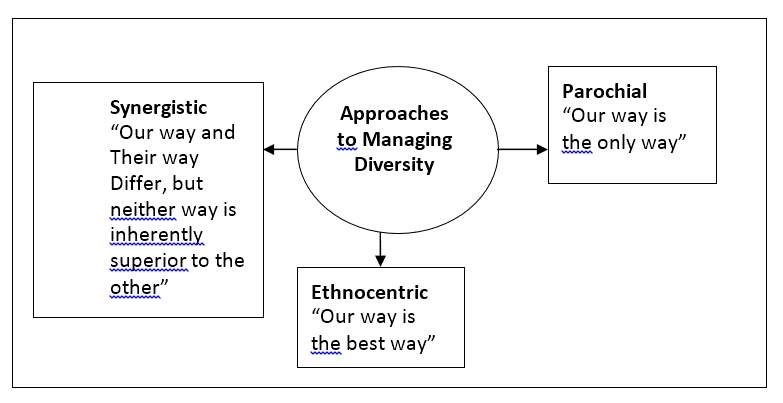
Figure 1: diversity approaches
From the three, Synergistic approach is preferable because it highlights on different social issues that are very critical in ensuring that a group of people remains balanced ethnically. The approach uses the similitudes and distinctions on the livelihood of a particular group of individuals who act as the sample population. Other than that, the technique is important in planning and creating authoritative frameworks as stated by (Adler, 1980). As the company is globally known creativity and innovations is among its key asset to oversee social diversity as a cooperative social energy. This approach is single of the utmost importance because it gives room for different ethnical groups without necessarily looking at their race, tribe, religion or age.
According to (Adler, 2002) there are four distinct stages in making social collaboration (Figure 1). From my findings, I discovered that the company experienced a greater change while trying to accomplish this cooperative energy. As stated by, (Adler, 2002) additionally recognized five techniques for overseeing social diversity. The most important one is social collaboration which can be achieved is open to other cultures while ensuring self-culture, and dissecting the company, I have discovered that it tries adapt to its surrounding cooperative social energy by placing contrast in the commercial centre, work surroundings, and gatherings.
Through working with people having the primary information for our study, one can figure out how highlight on issues from various factors causing an ethnic imbalance, and establish better methods for solving problems and in this manner can make cooperative social energy better within the organization (Laroche, 2003).First-hand information also increases the credibility of the source because it is one on one. One on one data collection ensures that there are no errors encountered due to omissions of data. However primary sources can also be misleading because some people can give out false information or one can experience communication barrier.
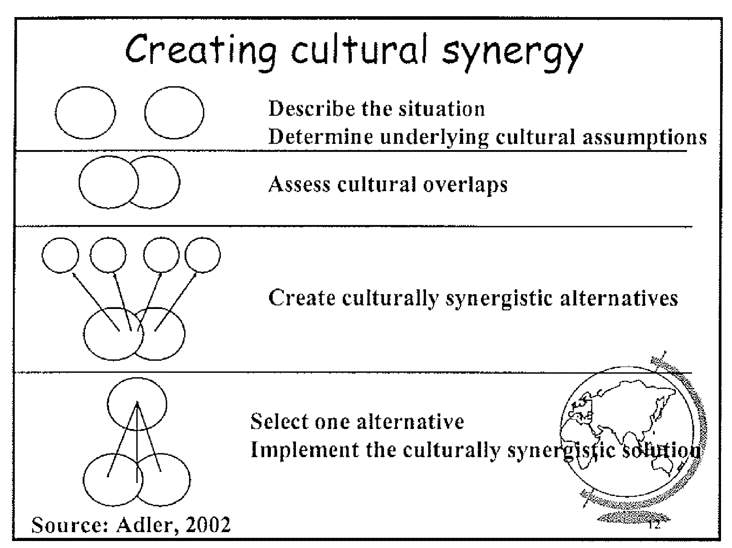
Figure 2: Cultural Synergy, as stated by Adler, 2002
According to (Ely, 2008) highlighted two noteworthy techniques and tools of significance on the proper ways to oversee ethnic diversity in an organization. One assortment or understanding diversity is looking at it like pluralism and other anxieties a partially blind shared characteristic among individuals. The primary model states that the difference between people are genuine, generous and noteworthy and in this way vital on how we treat one another; differences ought to be recognized and esteemed daily for bonding , as outlined by (Plaut, 2002). Same idea of decent variety was stated by (Frederickson, 1999) as societal pluralism, by (Thomas and Ely, 1998) as the point of learning as stated by (Berry, 1980) as reconciliation in the cultural assimilation writing.
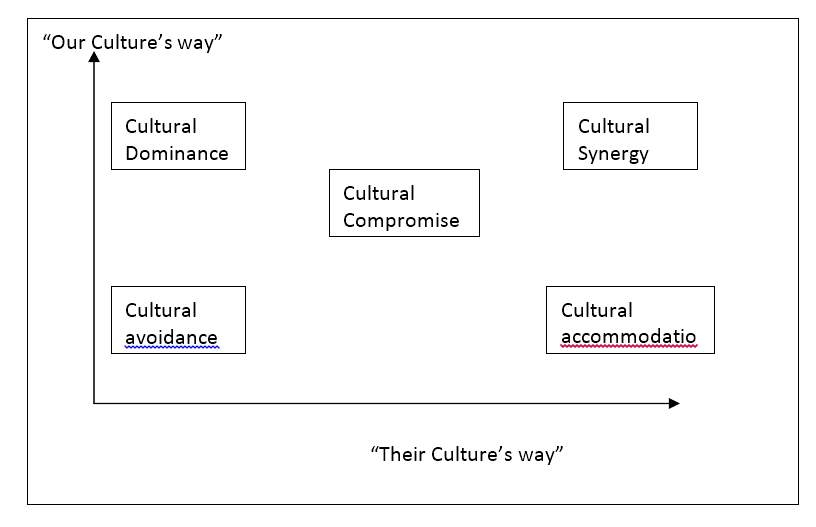
Figure 3: Strategies for addressing diversity, captured from Adler, 2002
Conversely, the visually challenged model of variety, suggests that distinction between people is just shallow and accordingly, unessential to demonstrate how people should view others as outlined by (Plaut, 2002). In this view, overlooking contrasts in everyday relationships stay away from strife. The essential similitude is the exemplary blend ensures that new employees absorb into the fundamental, existing character by leaving their old ways and taking part in the institution system. There are supporters for the model for instance, (Fredrickson, 1999) and one-way osmosis models and Berry in 1980 as absorption. Our outlook for the company is Pluralism as opposed to ‘mixture’ as it recognizes and values individual differences in societies. According to, (Ruffino, 2005) likewise denied ‘fusion’ approach and created five stage forms for turning into a decent variety intelligent individual. The means are fundamentally the same as (Adler’s, 2002) four stage procedure of making cooperative social energy.
Strategies adopted
According to, (Thomas & Ely, 1998) uses three Paradigms used in controlling of workforce diversity. Organizations take one of the two ways in overseeing decent diversity, for instance, the separation and reasonableness worldview and then get to and authenticity worldview. Before implementing specific worldviews, we might want to talk about each of them to some degree. The paradigms are divided into; discrimination and fairness which ensures that a company has strict rules and regulations which prevent mistreatment and discrimination based on race, gender or age. The second paradigm is access and legitimacy, which ensures that every worker has the right to access to relevant information and measures are implemented to ensure that every employer is covered by the law. Lastly, there is the learning and effectiveness paradigm which ensures that new employees can be taught the ways of the organization for easier adoption and putting strict measures to ensure that the organization has a diverse ethnic workforce.

Figure 4: Relationship of Diversity administration, by Thomas & Ely (1998
Data analysis from the field
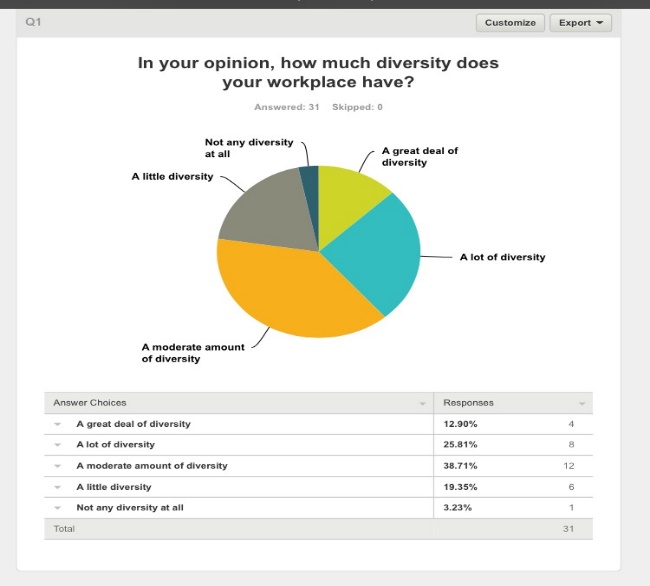
Figure 5: representation of diversity
From the data above 12.9 % of the workers agreed that there is a great deal of diversity at work. 25.1 % agreed that there is a lot of diversity in their institution. 38.71 % felt that there was a moderate amount of diversity in the company.18.38% of the population sample felt that there was little diversity in the company while 3.23% felt that there was no diversity at all. The population tested was 31 individuals. The uncertainty was because most of them were not aware of one but this could mean it’s not commonly known. From our analysis, it’s clear that a significant number of people feel that there is a moderate amount of diversity in the company while a small percentage feels that there is no diversity at all in the organization.
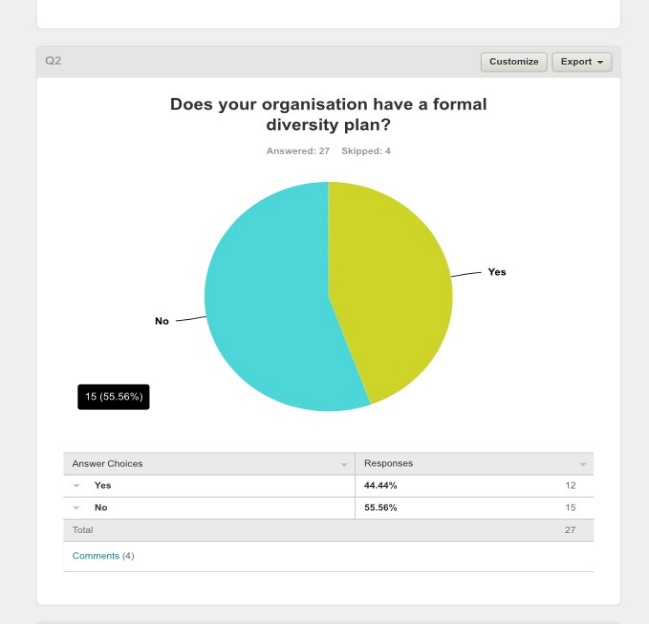
Figure 6: the organisation diversity plan
On the other hand, 44.44% were in agreement that the organization has a well elaborate diversity plan and acknowledged the contribution, but some commented that there is no effort to implement some of the policies. 55.55% were not in agreement. The total number sampled was 27.From this data, it’s manifestly evident that the majority of employees do not believe that there is a proper diversity plan within the company. This can be attributed to the lack of morale of the workers in the company which also reflects on the revenues generated by the agency. However, these outcomes can also be as a result of the company being new therefore not covering a wider customer base. Competition can also be a factor and the quality of their services.
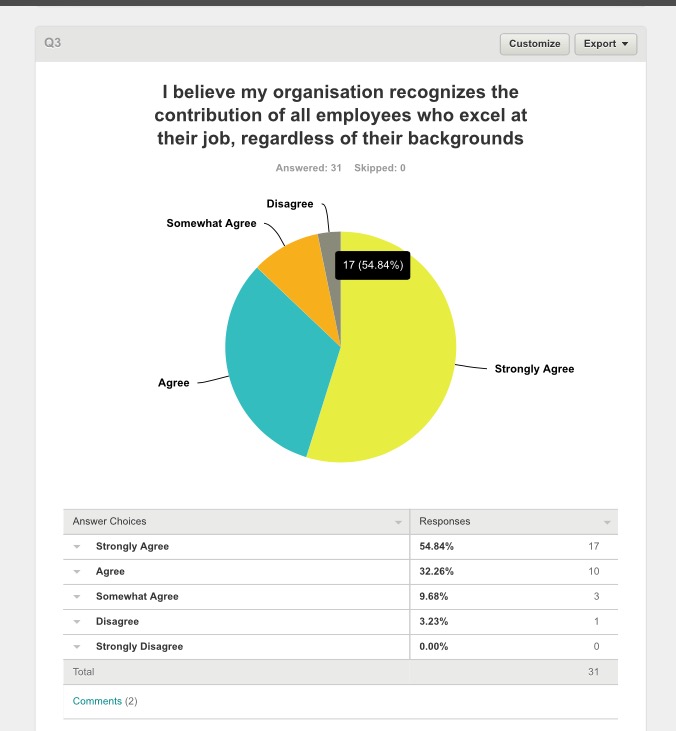
Figure 7: recognition of employees
54.84% strongly agreed that the company recognises the contribution of each and every employee, regardless of their background because they felt that the agency was fair and transparent. 32.26% decided to show support even though they had limited information.9.68% somewhat agreed, because they were still new in the company. 3.23% disagreed because they have never seen such privileges in the company. 0.00% strongly disagrees. The sample size was 31, however, from this analysis, it was clear that a huge number of individuals believed that the organization acknowledges workers who perform well without looking at their background.
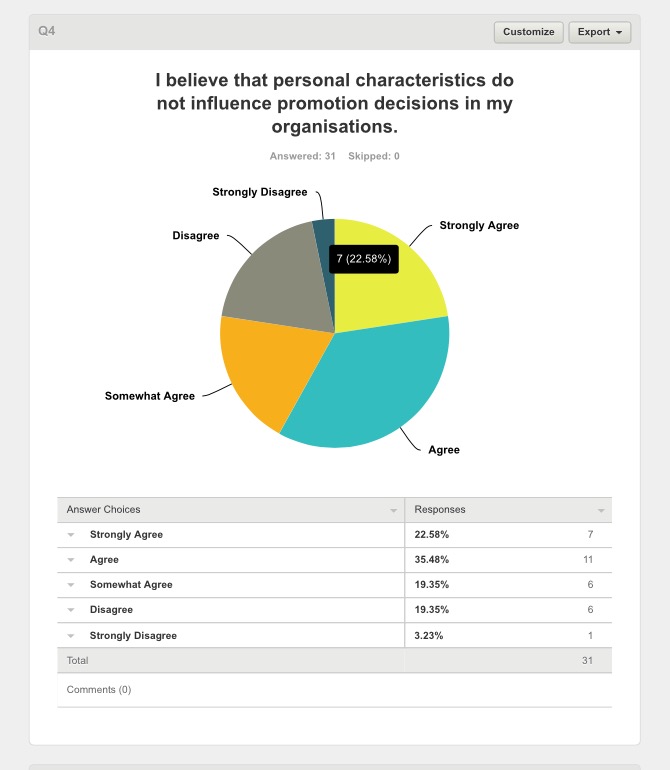
Figure 8: Employee recognition
22.58% strongly agreed that personal characteristics do not influence any form of decisions taken by the company with regards to promotion, because they argued that there were protocols to be followed before any promotion can be issued. On the other hand, 35.48% agreed, because they either felt they are not being promoted because of their ethical side or otherwise.19.35% somewhat agreed, due to insufficient information. 19.35% disagreed because they supported the company based on the performance and suitability of the person regardless of their ethnicity. “We don’t promote or hire to fill quotas” one of the employees stated. 3.23% strongly disagreed because they have either witnessed biases or heard some rumours around it. However there was a mixed reaction to beliefs about personal characteristics influence promoting decisions in an organization, but the majority only agreed that it wasn’t the case. The number of individuals who agree and disagree is also the same.
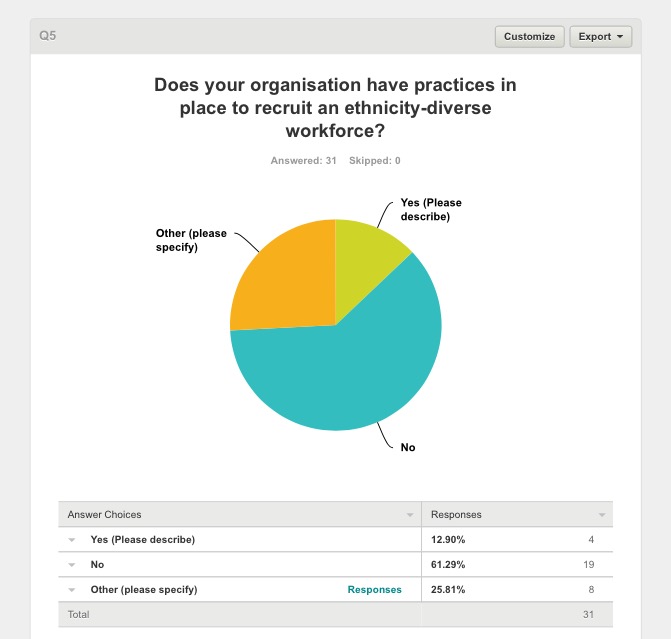
Figure 9: practises to recruit a diverse workforce
12. 60% of the sampled individuals felt that yes there organization had a unit established to hire an ethnicity –diverse workforce and they were asked to please describe the measures implemented. The main reason was because they have a department for that and qualified individuals are hired without looking at their ethical inclination. 61.29% Felt, then there were no measures put in place to control ethnicity-diverse workforce because there was no evidence to support it. However, there were other people who had mixed reactions, and this made about 25.81%from this study. It’s apparent that most companies are yet to implement departments which follow up on the ethnic workforce.
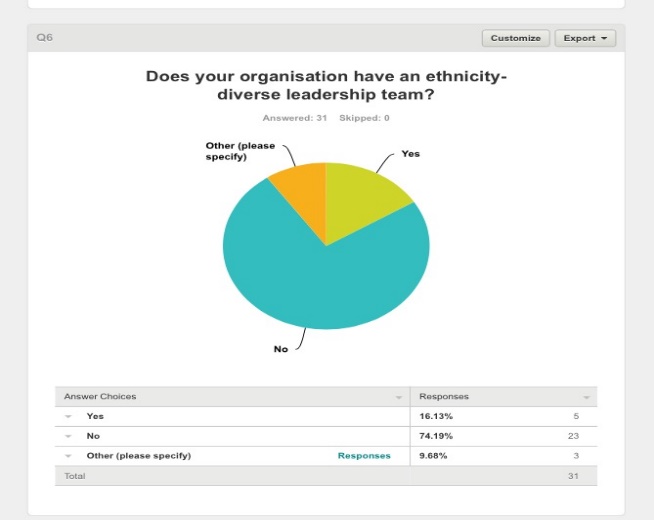
Figure 10: leadership diversity
16.13% of the sampled individuals said yes, they have a diverse ethnic leadership in position from the executive level to managerial levels.74.19% Did not agree that their organization has a different ethnic leadership in an area from the executive level to managerial levels.9.48% were not in a position to precisely determine whether or not the leadership in place is ethnically balanced or imbalanced. The great high percentage that represents the individuals who don’t agree that the leadership in place is ethnically balanced was notable.
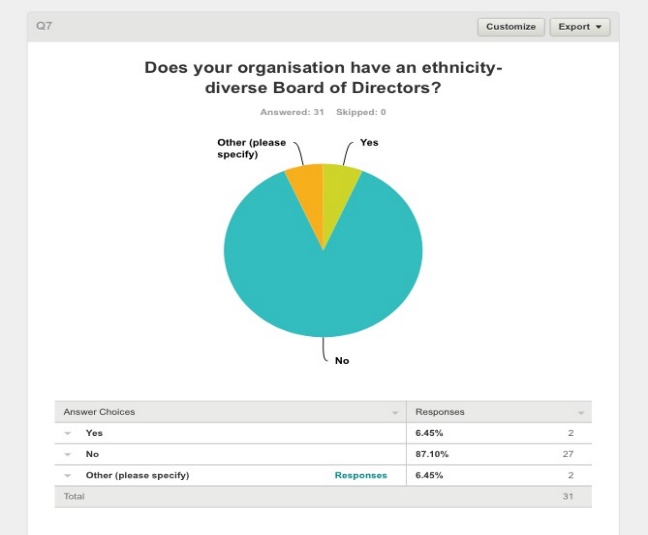
Figure 11: board of directors’ diversity
6.45 % agreed that the organization has an ethnicity-diverse Board of directors and they were contented with the way the activities of their company was run .87.10 % disagreed that the organization has an ethnicity-diverse Board of directors and they were contented with the way the operations of their business was being run forming the majority of individuals for the study. 6.45 % were not in a capacity to know whether the company has a diverse board of directors or not. This is because most of them have never been in the position to interact with the board of governors. The other reason may be most of them were casual workers and therefore had little information about the board of directors.
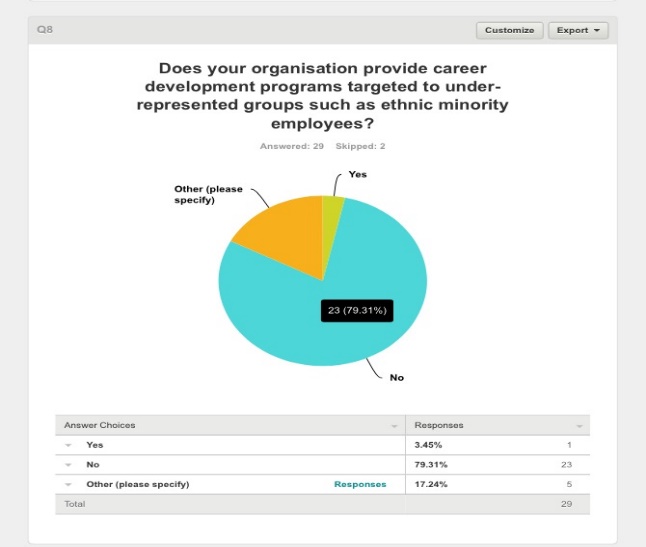
Figure 12: career development plans for minority groups
3.45 % agreed that the team provide career development programs targeted to less presented groups such as ethnic minority employees.78.31% Disagreed that the organization provides career development programs targeted towards the less represented groups such as ethnic minority employees. And this group forms a vast majority of the people who were sampled.17.34% were not sure whether the organization provides career development programs targeted to the lowly represented groups such as ethnic minority employees. This is because there was no evidence to show that the company provides career advancement programs with an aim to represent minorities.
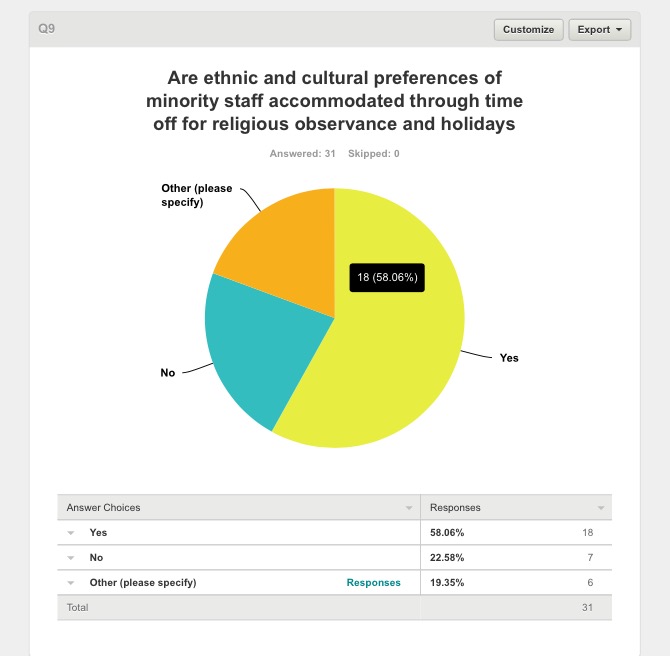
13: preferences in the company
54.06 % agreed that there are moral or ethical favours of lowly represented workers in cooperated through issuing time offs for religious activities and holidays. This might be due to their religious inclinations or relations within the institution or company. Which represents 18 individuals.22.58 % disagreed that there are ethical or ethical favours of lowly represented workers in cooperated through issuing time offs for religious activities and holidays. This might be because they’ve never seen the privileges.19.35 % were not sure on whether there is an ethical or ethical favours of lowly represented workers in cooperated through issuing time offs for religious activities and holidays. This may be because they have never seen any evidence of such privileges. This was because they have never heard of it happening. And holidays are probably accommodated through the flexi-time system.
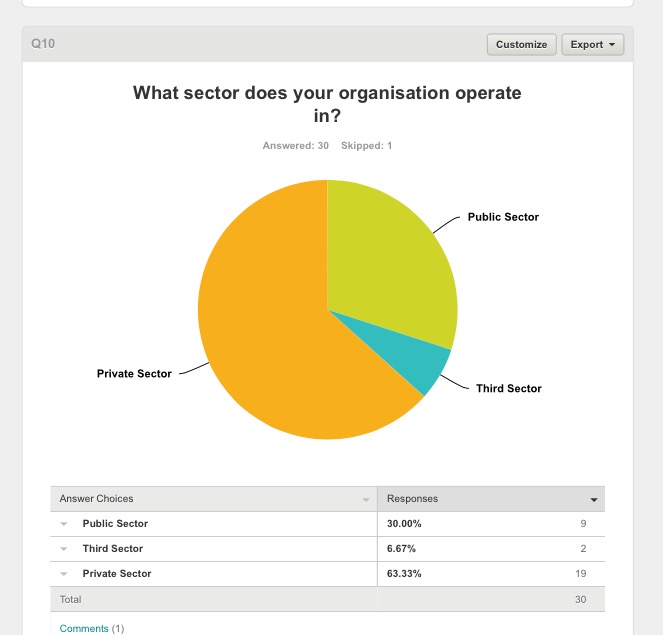
Figure 14: the company’s operation sector
30 % agreed that the business is in the public sector. This might be because of its partnership with the current government.6.67 decided that the company is the third area. This is because the company in cooperates the public and private sector in its activities and it has various investors apart from the government of the day.63.33 % were satisfied the organization operates under the industry. This is because of different private investors in the company. It was however imperative to interview the human resource manager to see whether some of his sentiments are the same with the other employees.
Human resource manager interview analysis
The manager agrees that the company has a diverse workforce because the company has put in place strict measures to ensure that there is no nepotism of any sort in recruitment practices. The manager also agreed that the company has a well elaborate diversity plan because the company has a hiring department under human resource which ensures that the company has balance ethical personnel without being biased towards a particular race or tribe. On the other hand the manager also acknowledged that the company has a strategy put in place to ensure that workers who perform exceptionally are highly rewarded without necessarily looking at where they come from. The company uses different performance appraisal techniques like vacations, salary increments, and promotions. The manager also agreed that an individual’s personal traits do not have a role to play in promotions, he argued that promotions are strictly made by human resource and what we look at our qualifications, an individual’s productivity and potential to make the company grow.
Furthermore, the manager agreed that the company has a well elaborate team working on recruiting a completely ethnic- diverse workforce. He said that the company has a team of highly trained recruitment officers under the human resource department who ensure that the hiring process is not ethical biased. With respect to the leadership in place, the manager said that, throughout the directors, executive and managerial leadership there is a diverse ethical team. The manager also acknowledged that the company has not yet put in place different measures for career advancement for the less represented ethnic groups, but the company is open and will look into that in the near future. The manager also discredited the fact that the company is believed to have ethical and cultural preferences, and stated that everybody is treated fairly and allowed to observe their religious rights and activities as well as take holidays. When asked about the sector under which the company operates, he said private because the company is run widely by investors and not the government.
From our interview with the human resource manager, it is evident that the views of employees to those of the employers are very different. There is also some form of limited access to information between the executives and the employees because most of them found it hard to answer individual questions, but the manager explained them clearly and with confidence. However, most benefits that are expected for performance appraisal have not been adequately looked into, but the manager was working on it but concerning hiring the manager insisted that it was strictly on a qualifications basis. Therefore there were no biases of any sort.
CHAPTER 5: CONCLUSION AND RECOMMENDATIONS
Wiping out diversity, recognizing and overseeing different ethnic groups is difficult in fact. Along these lines, every association that utilizes a varied collection of representatives ought to create individuals administration systems that contain contrasts out of sight, religion, ethnicity, angles and sex duties of their workers. In any case, every business ought to take after the arrangements of equal employment opportunity (EEO). The EEO approaches’ primary objective is to manage unwavering drawback experienced by special gatherings of individuals in the work environment. Work environment different variety standards ought not to remain a piece of the statement of purpose. It ought to be incorporated into all parts of human asset administration, “for example, arranging, choice and enlistment, execution examination, preparing and improvement, work related well-being and security and work environment relations” (Loden, 1996).
Decent diversity in the organization is one of the best fortunes and achievement openings, however, at a same time; it is one of the greatest difficulties in wording, as we saw above, makes separation of cultures difficult (Jackson, 1992). Every institution ought to support a diverse workforce. It is essential to recollect that to keep the odds of separate depression, it is imperative to comprehend what assorted variety is, that’s the reason it is critical, and how to viably deal with the business regarding the present globalization. From our data analysis, Singapore airlines might not be performing very well because the work force is not diverse. From our data, it is also evident that a high number of employees do not believe that the leadership in place supports a balanced ethical workforce.38.71 % of the people in the organization did not agree that the organization has an ethical, balanced worked force. Therefore, it’s upon the leadership in place to ensure that, they put in place better measures to ensure that they have a diverse workforce ethnically.
Despite the fact that the company has tried to change due to the rising worldview of diversity management and create a better working environment but, still, it has a chance to be better. Overseeing decent variety itself is an intricate wonder. To accomplish feasible upper hand from diversity, it needs to always screen and change its procedure towards proper diversity issues and endeavour to refresh its establishing standards. Moreover, as the company is doing a specific proficient business, similar to whatever other specialized firms, they should consider delicate aptitudes by and vast and relational abilities specifically as auxiliary to specialized talents for representatives. So they require additionally multi-faced work areas can build up their variety aptitude. Likewise, diversity coaches and Human resource directors need to deal with this touchy issue with due steadiness. We might want to prescribe a few techniques to actualize a multicultural model that creates a culture to help and support a broad range of representatives. These incorporate creating key initiative qualities, perceiving singular contrasts, giving input delicately and empowering multi-faceted mindfulness. For instance, there were considerable variability’s between the worker’s responses concerning the human resource manager. This can be due to poor implementation of different ethnic measures or merely negligence.
New idea is inescapable; creating a corporate culture is a path where by organizations fulfils their procedures. Once the company is centred principally on creating creative estimation and innovations will end up in a greatly aggressive advertisement department, increased revenues and performance appraisal can also be witnessed. The company built up a system for employees at the end of the year. In any case, in the most recent decades, services life-cycles wound up plainly shorter, and net revenues progressed toward becoming lower. Despite the fact that the company has left some of its unique strategies throughout the years to adapt to the speed of going global, it needs to assist advancement in the method for decent diversity administration considering a reduced service life cycle, quick mechanical improvement, and money related emergency of a world economy. Accordingly, change and use decent variety must be done in an efficient approach where this causes an organization is perceived as a social framework with a related part to catch the energy of diversity ultimately. This is particularly important for the company to put up different measures to adopt better ethnic diverse workforce. Even though the company currently doesn’t have any programs in place, the human resource manager was open towards creating one shortly.
I settled on Singapore airlines for a contextual investigation as a perfect case of decent diversity administration in the working environment. Appropriately, the company can be a pioneer in proper diversity management for Asia large corporate firms. As of late, we have watched an ever increasing number of enhanced individuals meet up in a similar working environment, their group spirit, decent social variety, multi-disciplinary foundation and proficient assorted variety administration encourages the association to be more fruitful. Additionally, research can be directed by considering another Asian organization and contrast its decent range department issue and translational or multinational organization and furthermore dealing with socio-social and financial conditions of the host nation. From the high percentage of data collection on the dissatisfaction of other employees on ethnicity, is directly proportional to the reduced sales and poor performance of different sectors within the company.
RECOMMENDATIONS
First and foremost, the top administration at the company must give a planned and precise push to enhance the decent variety and atmosphere of the workforce. Guarantee that new representatives to the enterprise are duly invited into their new units. We propose following the various steps which are stated above for the creation and implementation of an effective ethnic diverse workforce.
Guarantee that each and every person is well represented and has a mandate regarding the atmosphere of their department, by confronting their workmates with differences, though, and ensuring that they’re committed to their work environment. Employees need to be given the responsibility to perform this task. The workers should ensure that they portray the proper ethics relevant to work at all times. Not going against their moral obligation to try and approach their colleagues with a difference, people who coordinate different jobs have a mandate to ensure that the work environment is conducive for work. Senior workers need to be responsible and ensure that recruitment is done properly. Failure to do so, they should be held accountable because they are the ones in the position to change and implement the strategies for a balanced workforce.
Grow and advance grounds assets that give diversity and equity‐related preparing and aptitude so that the company representatives can achieve the new climate‐related work desires laid out in the suggestions above. However, this can only be done through ensuring that every step is taken seriously and followed to the latter.
Grow the financing and work force to help increase the five above proposals. Through, depicting how the suggestions connect the crevices in the present framework and how they accomplish the objective, expressed previously. Similarly, enhancing an atmosphere in each work unit at the company advances expanded occupation fulfilment and diminished wearing down of representatives. Representatives from underrepresented groups, specifically, will profit by more comprehensive and inviting work units and diversity will be upgraded. Enhanced maintenance of underrepresented people prompts enhanced enlistment of different workers.
Value among representatives is expanded when all officials approach an active and comprehensive workplace. This is through, putting moral obligation regarding working environment atmosphere in the position depictions and execution assessments of all the company representative’ guarantees responsibility for the development of diversity-and climate‐related objectives. At the point when the individuals who coordinate the work of others assume liability for the working environment atmospheres in their units, information and measurements are utilized to indicate advance towards diversity and value. Solid administration from the best will guarantee that suggestions are taken after, at all levels and in all units. Expanded assets and access to preparing and training give a foundation after that positive changes can be constructed.
REFERENCES
Adler, N. J. (1980). Cultural Synergy: The Management of Cross Cultural Organizations, in W.W. University Associates, pp.163-184.
Adler, N. J. (2002). International Dimensions of Organizational Behaviour, Fourth Edition, McGill University, South –Western, Thomson Learning, pp.105-131
Beck, V., & Williams, G. (2016). Managing Older Workers: A report for Acas. London: Acas.
Berry, J. W. (1980). Acculturation as Varieties of Adaptation. In A.M. Padilla (ed.), Acculturation: Theory, Models, and Some New Findings, Boulder: Westview, pp. 9-25.
Bobula , J. A., Anderson, L. S., Riesch, S. K., Canty-mitchell, J., Duncan, A., Kaiser-krueger, H. A., … & Angresano, N. (2004). Enhancing survey data collection among youth and adults: use of handheld and laptop computers. CIN: Computers, Informatics, Nursing, 22(5), 255-265.
Burke and L.D. Goodstein, eds., Trends and Issues in OD: Current Theory and Practice, San Diego, CA:
Bryan, J.H., (1999). The Diversity Imperative Managing people welt is the top priority. Executive Excellence, 16, pp.6-6.
Cascio, W. F. (1998). Managing human resource. Human Resource Management, 300-313.
Cox, T. H. Jr., and Blake, S. (1991). Managing cultural diversity: Implications for organizational competitiveness. Academy of Management Executive. 5(3), pp. 45-56
Ely, R. J., and Roberts, L. M. (2008). Shifting frames in team – diversity research: From difference to relationships. In A. P. Brief (ed.), Diversity at Work, Cambridge University Press, Cambridge, pp. 265-317.
Ely, R. J., and Thomas, D. A. (2001). Cultural Diversity at work: The effects of diversity perspectives on work group processes and outcomes, Administrative Science Quarterly, 46,pp.229-273.
Esty, K.C., Griffin, R. and Hirsch, M.S., (1995). Workplace diversity. Adams Media.
Fredrickson, G. M. (1999). Models of American ethnic relations: A historical perspective. In D.A.
Prentice and D. T. Miller (eds.), Cultural Divides: Understanding and Overcoming Group Conflict, pp. 2334, New York: Russell Sage Foundation.
Fisher, K. (2008). Five Blue Chips, Forbes, 9/1/2008, 182( 3), p110-110, Retrieved from
Academic Search Premier, September 5, 2008
Groeger, M. (2008). The HP Way – an example of corporate culture for a whole industry Retrieved from, http://www.silicon-valley-story.de/sv/hp_way.html on 20th of October,2008.
Hayles and Robert (1982). Costs and Benefits of Integrating Persons from Diverse Cultures in Organization, Conference paper presented on 20th International Congress of Applied Psychology, Edinburgh, Scotland, July 25-31.
Jackson, S. E. (1992). Diversity in the workplace: Human resources initiatives. Guilford Press.
Johnson, W. B., and Packer, A. E. (1987). Workforce 2000: Work and Workers for the 21st Century. Indianapolis: Hudson Institute.
Kandola, R., & Fullerton, J. (1998). Diversity in action: Managing the mosaic. CIPD Publishing.
Khattab, N., Sirkeci, I., Johnston, R., & Modood, T. (2011). Ethnicity, religion, residential segregation and life chances. In Global migration, ethnicity and Britishness (pp. 153-176). Palgrave Macmillan UK.
Kulik, C. T., and Roberson, L. (2008). Diversity initiative effectiveness: what organizations can (and can not) expect from diversity recruitment, diversity training, and formal mentoring program.In A. P. Brief (ed.), Diversity at Work, Cambridge University Press, Cambridge, pp. 265-317.
Konrad, A. M. (2003). Defining the domain of workplace diversity scholarship. Group and Organizational Management, 28, pp.4-17.
Kossek, E.E. and Lobel, A., (1996). Managing diversity. Blackwell Publishers.
Krueger, R. A., & Casey, M. A. (2000). A practical guide for applied research. A practical guide for applied research.
Laroche, L. (2003). Managing Cultural Diversity in Technical Professions, Butterworth Heinemann, Elsevier Science, USA, pp.18.
Loden, M. (1996). Implementing diversity (p. 16). Chicago, IL: Irwin.
Meyer, M., Xu, Q., & Gu, L. (2008). An analysis of the universality, flexibility, and agility of total innovation management: a case study of Hewlett–Packard, Journal of Technology Transfer, 32, pp 39-62.
Moffett, J. K., Torgerson, D., Bell-Syer, S., Jackson, D., Llewlyn-Phillips, H., Farrin, A., & Barber, J. (1999). Randomised controlled trial of exercise for low back pain: clinical outcomes, costs, and preferences. Bmj, 319(7205), 279-283.
Plaut, V.C. (2002). Cultural models of diversity in America: The psychology of difference and inclusion. In R.A. Shweder, M. Minow, and H. R. Markus (eds.), Engaging Cultural Differences:The Multicultural Challenge in Liberal Democracies, New York: Russell Sage Foundation, pp.365-395
Ruffino, N. C. (2005). Making Diversity Work, Net Effect Series, Pearson, Prentice Hall, Upper Saddle River, New Jersey, pp.23.
Rijamampianina, R. and Carmichael, T. (2005). General Issues in Management; A Pragmatic and Holistic Approach to Managing Diversity, Problems and Perspectives in Management, Chapter 3, Pp.109117. Retrieved form http://web.ebscohost.com.ezproxy.lib.unimelb.edu.au/ehost/pdf. on 21st October, 2008.
Schneider, B. (1987). The people make the place. Personnel psychology, 40(3), 437-453.
Schuler, D., & Namioka, A. (Eds.). (1993). Participatory design: Principles and practices. CRC Press.
Seltzer, D., (1997). Federal Income Tax Compliance Costs: A Case Study of Hewlett-Packard Company, National Tax Journal, Vol. L No. 3.
Thomas, D. A., and Ely, R. J. (1996). Making differences matter: A new paradigm for managing diversity. Harvard Business Review, September-October, pp. 79-90.
Thomas, D. A., and Ely, R. J. (1998). Making differences matter: A new paradigm for managing diversity, In Francesco, A.M. and B. A. Gold (eds.), International Organizational Behaviour, Text, Readings, Cases, and Skills, Prentice Hall, Upper Saddle River, New Jersey, pp. 401-416.
Torres, C. and Bruxelles, M., (1992). Capitalizing on global diversity. HR MAGAZINE, 37, pp.30-30.
Williams, K., and O’ Reilly, C. A. (1998). Demography and diversity in organizations, A reviewof 40 years of research. In B. Staw and L.L. Cummings (eds.), Research in Organizational Behaviour, 20, Oxford, UK: Elsevier Science Inc., pp.77-140.
Ziller, R. C. (1972). Homogenity and Heterogenity of Group Membership, In C.G. McClintock, (ed.), Experimental Social Psychology, New York, pp. 385-411.
Appendix
Table A3. Contribution to Sales by Region (2004)
Region % of total
|
Table A4: SIA’s First Place in Airline of the Year 2004
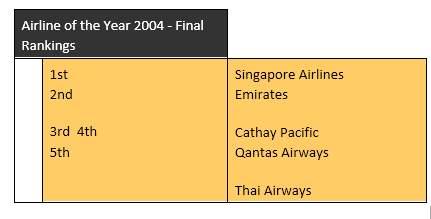
Questionnaire
Highlight on the item that best fits the answer to the described question. . 1 stands for strongly agree, 2 stands for somewhat agree, 3 stands for moderate, 4 stands for disagree and 5 stands for strongly disagree
PART 1: Personal information
Kindly put a tick on the item that best fits the answer to the description.
Age
20-30 31-40 41-50, 51 and above
Gender
Male Female Transgender
Length of service in job (years)
Less than 1 1- 2 3-4 5-6 7-10 more than 10
Length of service in organization (years)
Less than 1 1- 2 3-4 5-6 7-10 more than 10
| No. | Questions | Strongly agree | agree | disagree | Not sure |
| 1. | In your opinion, how much diversity does your workplace have? | ||||
| 2. | Does your organization contain a formal diversity plan? | ||||
| 3 | Do you believe your organization recognises the contribution of all employees who excel at their job regardless of their background? | ||||
| 4 | Do you believe that personal characteristics do not influence promotion decision in your company? | ||||
| 5 | Does your organization have practises in place to recruit an ethnic diverse workforce? | ||||
| 6 | Does your organisation have a diverse leadership team? | ||||
| 7 | Does your organisation have an ethnic diverse board of directors? | ||||
| 8 | Does your organisation promote career development programs targeted to the less represented workers? | ||||
| 9 | Are ethnic and cultural backgrounds of the less represented workers accommodated in time off and holidays? | ||||
| 10 | What sector does the company operate in? | ||||
Cite This Work
To export a reference to this article please select a referencing stye below:
Related Services
View allRelated Content
All TagsContent relating to: "Workplace Training"
Workplace training enhances or teaches new skills to employees to help improve efficiencies and confidence in carrying out a job role. Increased skills and knowledge also improves job satisfaction and career progression which can make employees more loyal to a company, reducing staff turnover.
Related Articles
DMCA / Removal Request
If you are the original writer of this dissertation and no longer wish to have your work published on the UKDiss.com website then please:




